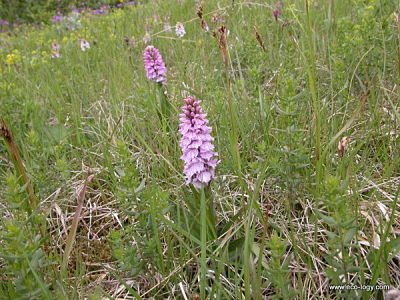BOTANY NEWS
Botanical Information
Welcome to this second issue of Botany News!
TOPICS:
1. A note from the editor.
2. Plants grown in northern gardens: Cotoneasters.
4. Berries in the heath.
5. Send in more news!
6. The flower box.
Visit our website: Eco-Logy.com
--------------------------------------------------------------------------------
A note from the editor
HAVE A NICE SUMMER! Welcome to Botany News, a botanical newsletter based in Reykjavik, Iceland. I hope you enjoy the content of this newsletter. A special welcome to new subscribers. The world of plants is full of wonders, just imagine tumbling weeds in the desert or miniscule herbs in the Arctic to name a few! Some of you are already signed up and are receiving Botany News via email. Others may have found this newsletter though ezine directories, where electronic newsletters are classified according to topics. Botany News depends on enthusiastic readers, willing to exchange information on plants and events in botany. Please, feel free to send us your questions in relation to any botanical topic!
Plants grown in northern gardens: Cotoneasters
Several species of cotoneasters are grown here in Iceland including Common Cotoneaster (Cotoneaster integerrimus). The Creeping Cotoneaster (Cotoneaster adpressus) which as the name indicates trails along the ground. Shiny cotoneaster (Cotoneaster lucidus) bearing small pink flowers, growing well in our cold climate and on garden soils that often are a good mixture of sand, clay and organic matter. Cotoneasters are low growing flowering shrubs, thriving best in sunny places. The leaves are oblong and entire; both evergreen and deciduous species occur. The flowers are commonly produced in late spring through early summer. The flower are somewhere in the spectrum of white to pink. The fruit is a small berry and bright pink, high red and even pitch black when mature. On some species the fruit stays on until the following year. In the autumn these bushes turn yellow to orange. They are hardy and grow well even if the soils are only average. Cotoneaster is a genus of woody plants in the rose family, Rosaceae, native to temperate Asia, Europe and North Africa and very common in the mountains of south-western China and the Himalayas. The flowers and fruit attract many butterflies, moths and birds. In warmer climates the cotoneasters have a reputation for escaping from cultivation and become roadside weeds. While these species grow best on open grounds, such as coastal areas and roadsides, they are also quite capable of invading well-shaded forests. The majority of cotoneasters are shrubs, while there is a spectrum of life-forms ranging from low-creeping plants to erect shrubs.
Berries in the heath
Heaths in Iceland typically have many low-growing species of shrubs as well as slightly taller growing willow and sometimes birch or dwarf birch. Commonly the shrub vegetation has scattered patches of sedges, grasses and even mosses. The low growing shrubs include crowberry (Empetrum nigrum), heather (Calluna vulgaris) and Berberry (Arctostapylos uva-ursi) and two species of Vaccinum. The two species of Vaccinum are Bog Blueberry (Vaccinium uliginosum), common all over the country while Billberry (Vaccinium myrtillus) is common in most parts of the country except parts of South Iceland. These species like other low-growing shrubs are long-lived perennials. Both species are low growing often forming large mats on south facing slopes and depressions, where in winter they where protected from exposure by layers of snow. The rather narrow creeping stems of Bog Blueberry are brown with dark green leaves, whereas Billberry commonly has green branches and light green leaves. In the early summer both species are decorated with bell-shaped whitish flowers. If fertilization is successful these develop into tough green and later soft and juicy berries. Used in earlier times in Iceland for blue colouring of clothes as a substitute for indigo. The juicy berries are also an excellent source of vitamin C and minerals. In late summer people from towns and farms in Iceland go berry hunting on all open-access areas, picking the berries into bags and buckets either manually or using a specially designed equipment. If you are in Iceland you can look forward to this treat in late summer. When in Iceland try also the speciality skyr (a skimmed-milk yogurt) topped with berries and pour some cream on top!
-----------------------------------------------------------
Send in more news!
You can write on any topic related to botany. Short essays on plant biology are especially welcome. It can also be a review on recent botanical developments. Anything that will help other botanists and make it possible for them progress in their work! The articles need only be 300-400 words. The editor may request some changes and articles that do not fit the profile or purpose of Botany News are not published. Reader’s surveys are also an important way you can help shape this newsletter. Contact us or send us your letter. --------------------------------------------------------------------------------
A special announcement to Icelandic readers: - Tilkynning! Sendið okkur bréf og greinar um plöntur, gróður og jafnvel garðyrkjuna ykkar til birtingar í næsta hefti Gróðurfrétta (Botany News), þið getið líka skoðað og leitað í fyrri heftum. Miðlið af ykkar eigin fróðleik til lesenda Gróðurfrétta um efni eins og jurtir og tré, ræktun plantna og plöntuskoðun. Þá má senda okkur tilkynningar og greinar um fjölbreytt efni tengt náttúru landsins, ferðalögum og garðyrkju. Sendið okkur endilega myndefni til birtingar með greinunum. Ef til vill sækist þið eftir náttúrlegum gjafavörum og þá má skoða á sölusíðu Þundar, te og jurtavörur frá Þund henta vel til gjafa. Ekki er úr vegi að setjast út í sólina, í garðkrókinn, á pallinn eða á svalirnar með bolla af heilsutei frá Þund. Mælum með Streitutei og Bláa teinu nú í sumar, sérstaklega gott í lok dags! Síðan eru alltaf þessi sígildu, eins og Yerba mate og Kryddte.
The flower box
Botany News aims at providing articles of general botanical interest to readers from around the globe. You are welcome to send us a line, e. g., a letter or brief article, related to the general theme of this newsletter. If you like this ezine/newsletter perhaps, you could send your friends the link to subscribe to this online ezine, Botany News! All suggestions for improving this ezine and the Eco-Logy.com website are welcome. Read on! Botany News welcomes communications from persons working on all aspects of botany and many related issues. We welcome input from persons working on botany, biodiversity and plant conservation around the world. Please, feel free to suggest new links to interesting botanical and green sites for the next Flower Box section. The summer is the best time to participate in nature tours such as the Botanical Day Tours in Iceland offered by Thund. There are now three different options on offer depending on your special set of interests. Contact us about booking one of our Botanical Day Tours and feel free to ask us to assist you with your travel logistics in Iceland such as reducing costs, e. g. booking affordable accommodation and friendly farm stays and buying food in green shops and restaurants. How to stay healthy, where to eat/drink healthy, how to make the travel less stressfully on land or on sea. How to do your shopping for eco-friendly gifts, wooden handicraft, flora books, woollens and skin fashion and nature art.
-----------------------------------------------------------------
Best wishes,
BOTANY NEWS is published by Thund, Reykjavik, Iceland.
June 16, 2010 -- Botany News, Issue #013



Fáðu nýjustu fréttir og tilboð frá Þund!
Get updates and special offers from Thund!










